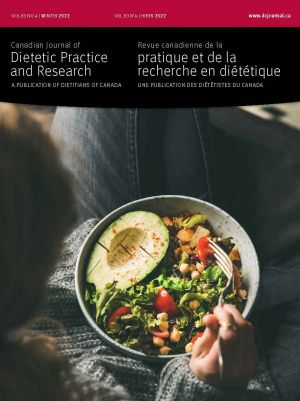Volume 73 • Number 4 • December 2012
Chair’s Message
Editor’s Message
Research
Purpose: The experience, reasons, and contexts associated with leaving vegetarianism were explored. Methods: Interviews were conducted with a convenience sample of 19 ex-vegetarians and 15 continuing vegetarians. Results: Exiting vegetarianism is similar to the process of leaving other important individual identities, including exiting diets containing meat. It is a process, not an event, and partially a response to inconvenience, particularly when the person's table companions were not vegetarians. Major life changes and declines in self-perceived health provided occasions to reassess life choices, including the vegetarian commitment. Ex-vegetarians interpreted their vegetarianism as a transition to a new, healthier diet. Including a comparison group of continuing vegetarians revealed that the ex-vegetarians were more likely to have become vegetarians as a result of concern about the well-being of animals and the environment, not animal rights, a value more difficult to compromise. Conclusions: Exiting processes show the five central food values of taste, health, time, cost, and social relationships undermine people's commitment to a diet chosen largely for moral reasons.
Purpose: We describe factors influencing the career choices of students enrolled in Canadian dietetics programs. Methods: A survey was administered, in class or online, to core first- and fourth-year classes in seven dietetics programs in various provinces (n=397). Data were analyzed with the use of descriptive statistics. Chi-square testing for independence established significant relationships. Results: Students ranked personal satisfaction, job security, and a professional career as important general career outcomes. These factors were also perceived to be attainable through a dietetics career. The majority of students chose dietetics while they were enrolled in a post-secondary degree program (44%), were primarily influenced by family members (54%), and based their choice on information acquired through the media (50%). Motivations for choosing dietetics included an interest in nutrition (91%) and health (90%), and a desire to help others (82%). Younger students placed more importance on economic rewards and having a position of authority than did older students. Older students identified personal satisfaction as more important in career selection than did younger students. Female respondents placed higher value on job flexibility than did their male counterparts. Conclusions: Career choice is based on a variety of internal and external factors. Opportunities exist for strategic recruitment efforts by educators and the profession.
Review
Registered dietitians (RDs) are regulated health professionals in short supply in Ontario and throughout Canada. Projected workforce studies indicate the situation will likely worsen. Accessing these nutrition specialists is an even greater concern for residents living in rural or remote regions of the province. Smaller communities are increasingly using telehealth as a way to deliver health care services and to improve access to health care professionals. The adoption of interactive videoconferencing as a telehealth application is examined as an alternative approach for accessing RDs in rural communities. While valid reasons exist for implementing videoconferencing, other issues must be considered. These include costs, technological requirements, organizational readiness, and legal and ethical concerns. Future research must fully address the concept of videoconferencing in relation to the Canadian dietetic workforce and practice requirements.
Perspectives in Practice
In recognition of the growing challenge that food insecurity has on population health, a multisectoral partership in Nova Scotia has been working since 2001 to address province-wide accessibility to a nutritious diet. The participatory food costing (PFC) model has been at the forefront of provincial and national efforts to address food insecurity; a local foods component was incorporated in 2004. This model has engaged community partners, including those affected by food insecurity, in all stages of the research, thereby building capacity at multiple levels to influence policy change and food systems redesign. By putting principles of participatory action research into practice, dietitians have contributed their technical, research, and facilitation expertise to support capacity building among the partners. The PFC model has provided people experiencing food insecurity with a mechanism for sharing their voices. By valuing different ways of knowing, the model has faciliated muchneeded dialogue on the broad and interrelated determinants of food security and mobilized knowledge that reflects these perspectives. The development of the model is described, as are lessons learned from a decade of highly productive research and knowledge mobilization that have increased stakeholders’ understanding of and involvement in addressing the many facets of food security in Nova Scotia.
Dysphagia is highly prevalent in patients with chronic neurological disorders and can increase the risk for comorbidities such as aspiration pneumonia and malnutrition. Treatment includes timely access to interdisciplinary health care teams with specialized skills in dysphagia management. A retrospective chart review (n=99 of 125 charts screened) was conducted to evaluate the effectiveness of referral criteria to identify and triage patients with suspected dysphagia to an ambulatory dysphagia clinic. Variables collected included demographic information (age), anthropometric information (body mass index [BMI], each patient’s sex), reason for referral, primary medical diagnosis, symptomatology (e.g., pneumonia, chest congestion), nutrition and swallowing interventions, clinic wait times, missed/cancelled appointments, and referring health care professional. The mean age and mean BMI ± standard deviation of patients reviewed were 68.7 years ± 18.4 years and 25.2 kg/m2 ± 6.7 kg/m2, respectively. Average clinic wait times were 158 days (13 to 368 days) for routine and 52 days (0 to 344 days) for urgent assessments (p<0.001). The most common reason(s) for referral was/were related to dysphagia (n=83), surgery (n=50), and/or gastrointestinal symptomatology (n=28); 80% to 90% of patients received varying diagnostic and treatment services for dysphagia. Development of effective referral criteria is critical to ensure that clients with dysphagia receive timely diagnostic, treatment, and nutrition interventions by interdisciplinary health care teams specializing in dysphagia.
The purpose of this study was to identify dietary patterns among patients with advanced cancer. Differences between cancer groups are described, and food groups contributing higher proportions to overall caloric intake are identified. Patients with advanced cancer (n=51) were recruited from a regional cancer centre and completed a three-day dietary record. Food items were categorized according to macronutrient content. After adjustment for body weight, substantial variation in energy intake was observed (range: 13.7 to 55.4 kcal/kg/day). For 49% of patients, protein intake was below recommendations. Overall, patients consumed the largest proportion of their calories from meat (16%), other foods (11%), dessert (9%), fruit (9%), white bread (7%), and milk (7%). Only 5% of patients consumed meal replacement supplements. The results of this descriptive study provide important insights into the dietary habits of patients with advanced cancer. These insights could be translated into the development of effective recommendations for maintaining or improving health and quality of life.
Report
Purpose: Levels of adherence to pancreatic enzyme supplementation were investigated in Atlantic Canada adolescents with cystic fibrosis (CF). Methods: Participants were recruited from CF clinics at the Izaak Walton Killam Health Centre in Halifax, Nova Scotia, and the Janeway Children’s Health & Rehabilitation Centre in St. John’s, Newfoundland and Labrador. Self-report questionnaires were mailed to potential participants (n=51) by clinic staff and completed surveys (n=9) were mailed to the principal investigator. Results: Nine adolescents (mean age 15.2 ± 1.9 years) participated in the study. The adherence survey indicated that the majority perceived themselves to be adherent to taking enzymes with meals (67%), but only 44% perceived themselves to be adherent to taking enzymes with snacks. Recorded amounts of enzymes, taken over three days, indicated that 67% of participants were actually adherent to taking enzymes with meals and 56% with snacks. Including those who correctly predicted non-adherence, 56% and 44% of participants accurately predicted their adherence to taking enzymes with meals and snacks, respectively. Conclusions: Adherence rates in the literature vary because of differences in definition and measurement. In the CF population, adherence has been shown to have a positive effect on quality of life. Results for this small group of patients suggest that Atlantic Canada adolescents with CF are able to estimate correctly their adherence to taking pancreatic enzymes, but definite conclusions cannot be made because of the small number of respondents.
Purpose: The effectiveness of different front-of-pack nutrition rating systems and symbols (FOPS) has not been studied among Canadians. We pilot tested an online FOPS survey with consumers. Methods: Members of the Guelph Food Panel were randomly exposed to traffic light, Percent Daily Value, Health Check, and Smart Pick logos on mock food packages and were asked to rate the FOPS on a Likert-type scale. The FOPS were rated on consumers’ ability to understand them, credibility, and influence on purchase decisions. Participants also provided feedback on the survey. Results: Participants (n=337) deemed the survey appropriate in length and language, and provided suggestions for improving survey clarity. More than 50% of the respondents believed that FOPS should be present on all food packages (65.1%) and should be government regulated (53.0%). The Percent Daily Value symbol was rated highest with respect to liking, credibility, helpfulness, and influence, but was the least understood. When they used direct comparison, consumers preferred the traffic light symbol (53.1%) over the Percent Daily Value (40.0%), Health Check (6.7%), and Smart Pick (0.3%) symbols. Conclusions: The survey was revised as a result of the pilot study feedback. Preliminary findings from this pilot study suggest that consumers prefer a single, government-regulated symbol, and value more complex FOPS, like the Percent Daily Value symbol, despite finding them harder to understand.










